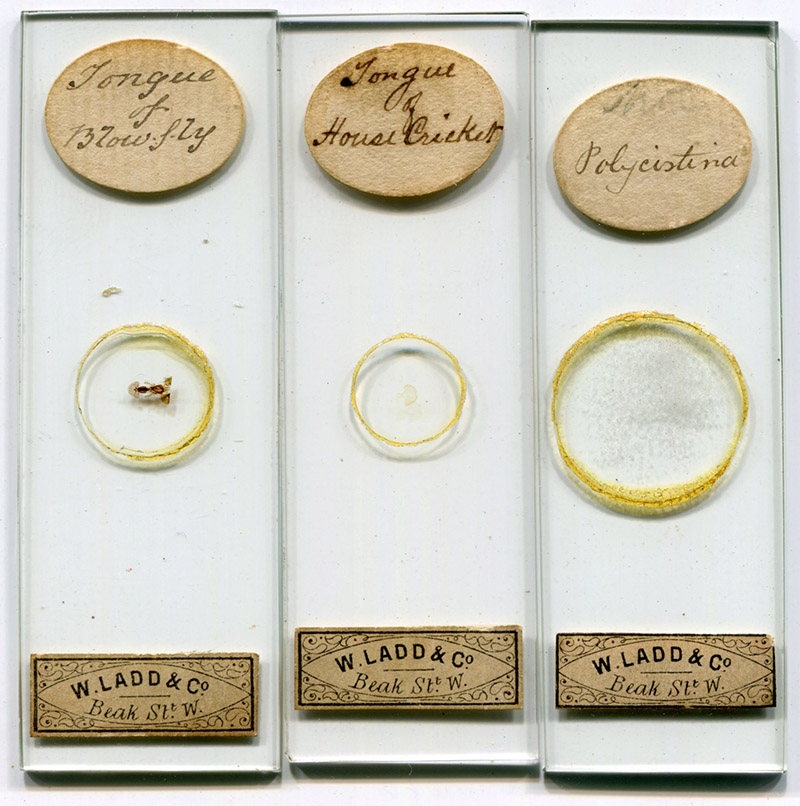
Figure 1. Rare microscope slides that were retailed by William Ladd. The notation “W. Ladd & Co.” dates them to between ca. 1871 and 1882.
William Ladd, 1815 - 1885
by Brian Stevenson
last updated July, 2024
William Ladd operated a business of making and selling microscopes and other scientific instruments from 1842 or 1843, until 1882 (Ladd cited both ’42 and ’43 as the year he began business). He is especially well-remembered for his microscope’s chain-driven focusing mechanisms. He also produced standard rack-and-pinion microscopes, especially early in his career. Occasionally, microscope slides are encountered that were retailed by Ladd. During his time, Ladd was also known for his pneumatic apparatus and groundbreaking forays into electricity.
Ladd’s business occupied five different locations in London and surrounds, so engravings can be useful to date instruments. Gloria Clifton reports that Ladd was located at 10 Cleaver Street in the 1846 Post Office directory. The 1841 census placed Ladd at 3 Cleaver Street, Kennington, Lambeth, Surrey, so it is likely that he made a short move to number 10 when he opened his independent operation in 1842/43. The 1851 census recorded Ladd as living at 29 Penton Street, Walworth, Surrey (the use of “Street” or “Place” seems interchangeable, as Ladd’s 1851 neighbor was recorded as living at 30 Penton Place). The Penton address is also on patent records dating as far back as 1850. A letter to Scientific American stated that one J.R. Remington “boarded and lodged at Mr. Ladd's, mathematical instrument maker, Amelia St., Penton place” during early 1848. Further narrowing down the move from Cleaver to Penton, a bankruptcy notice for Ladd’s sister, Sarah Mummery Ladd, published November 27, 1846, described her as “formerly of No. 10, Cleaver-street, Princes-square, Kennington, then of No. 29, Penton-place Walworth, both in Surrey”. It is reasonable to assume that William’s sister’s moves coincided with his own, so he probably moved to Penton Place during 1846. Ladd was still located on Penton at the time of the 1855 Paris Exposition. Advertisements from early 1857 onward give the address 31 Chancery Lane, London. Please note that some sources misread the script “31” as “34”. Beginning on September 22, 1860, a series of advertisements in The Lancet announced his move to 11-12 Beak Street, near Regent Street, London. The business incorporated between 1870 and 1872, becoming “W. Ladd & Co.”. A branch office was opened on Brompton Road in 1872. Ladd sold his business in 1882. To summarize, William Ladd’s business locations and dates were:
10 Cleaver Street, 1842/43 - 1846
29 Penton Place, Walworth, 1846 - ca. 1856
31 Chancery Lane, 1857 - 1860
11-12 Beak Street as “W. Ladd”, 1860 - ca. 1871
11-12 Beak Street as “W. Ladd & Co.”, ca. 1871 – 1882
11-12 Beak Street and 199 Brompton Road as “W. Ladd & Co.”, 1872 - 1882

Figure 1.
Rare microscope slides that were retailed by William Ladd. The notation “W. Ladd & Co.” dates them to between ca. 1871 and 1882.
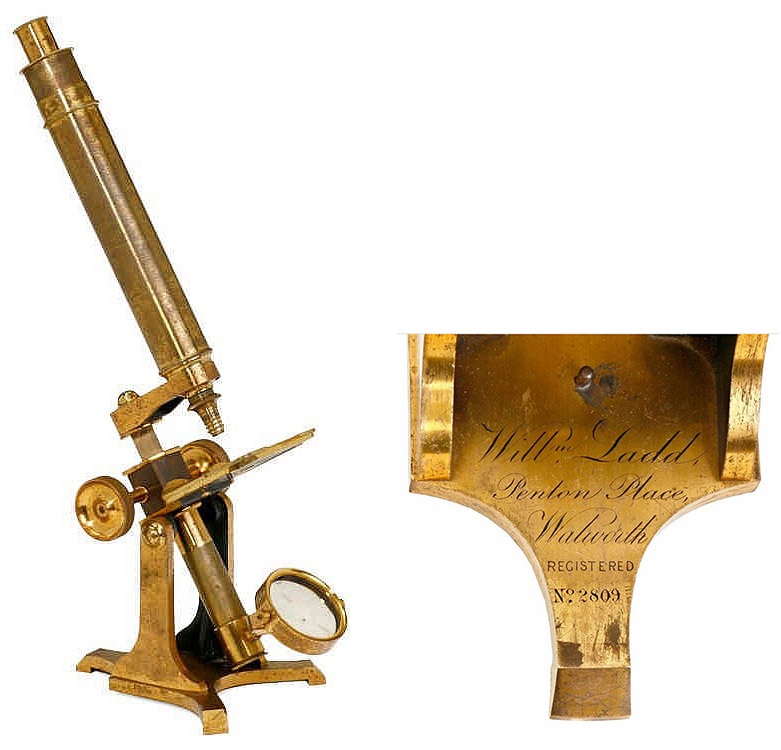
Figure 2.
A Ladd microscope signed "Willm Ladd, Penton Place, Walworth, no. 2809”. The coarse focus is traditional rack-and-pinion. Ladd applied for patent 2809, dealing with “adjustments for microscopes”, on May 13, 1850. Thus, he made this microscope between 1850 and ca. 1855. Adapted from an internet auction site, for nonprofit, educational purposes.
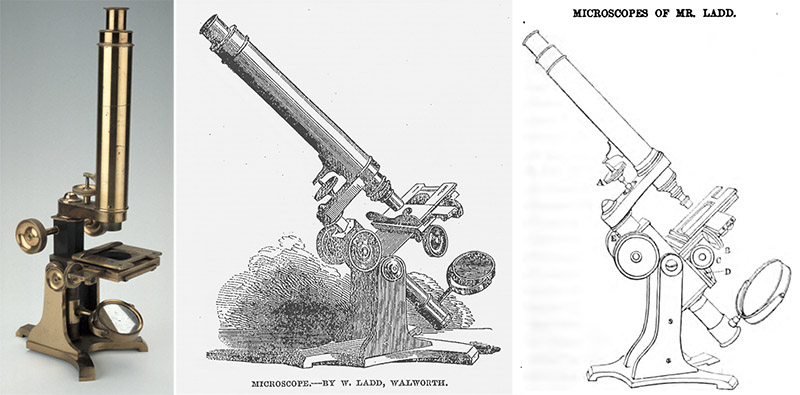
Figure 3.
Left, a Ladd chain-focus microscope. It is marked on the foot "W. Ladd Penton Place Walworth Registered N° 2809", thus dating it to between 1850 and ca. 1855. Middle, an 1852 engraving of such an instrument, exhibited by Ladd at the 1851 London International Exhibition. Right, a drawing of a similar microscope, from John Quekett’s 1855 edition of “A Practical Treatise on the Use of the Microscope”. Quekett wrote “the adjustments for focussing, as well as the movements of the stage, are accomplished by a steel chain and spindle instead of the rack-work or screw usually employed. One of the first of Mr. Ladd's microscopes was shown in the Great Exhibition of 1851, and a description of it given in the Illustrated London News of January 3rd, 1852”. The photograph in the left panel is adapted from the Museum of the History of Science, http://www.mhs.ox.ac.uk/collections/imu-search-page/record-details/?thumbnails=on&irn=9946&TitInventoryNo=56180, for nonprofit, educational purposes.
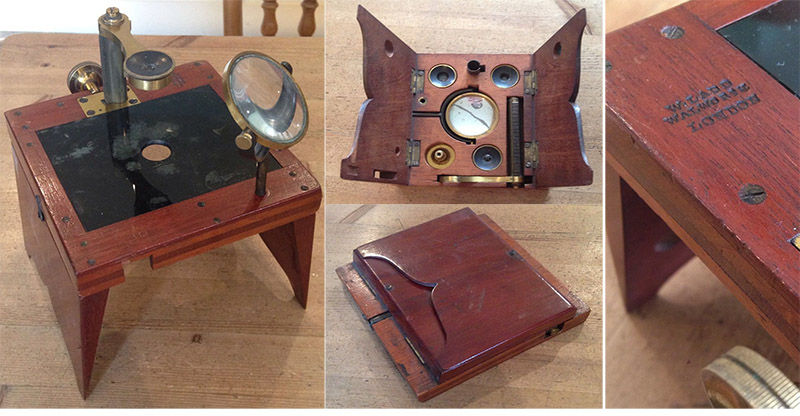
Figure 4.
A “Quekett” pattern dissecting microscope, stamped “W. Ladd, Walworth, London”, dating it to 1856 or earlier. All of the brass and glass pack into the base of the wooden instrument, and the legs fold over that, making a compact package of about 4 x 4 inches (10 x 10 cm). Samuel Highley produced a version of this instrument at the same time. Images adapted from an internet auction site.

Figure 5.
An advertisement from The Lancet, September 27, 1856.

Figure 6.
A Ladd “Jackson” pattern microscope, engraved “W. Ladd, 31 Chancery Lane, London”. Focuses by chain drive. Another copy of this instrument, marked “W. Ladd, 11-12 Beak Strt, Regent Strt, W” is shown on page 77 of Gerard L. Turner’s “Collecting Microscopes” (the address given in that resource has a typographical error). A similar instrument, but with rack-and-pinion focusing, is shown in Turner’s “The Great Age of the Microscope” and attributed to George Jackson (illustration 82, page 95). The Jackson pattern offers a rigid optical plane, “the construction of the continuous bar supporting the body of the instrument above the stage, and carrying a small secondary body below, the whole bar being planed from end to end on one level…no centering or adjustment is required”.
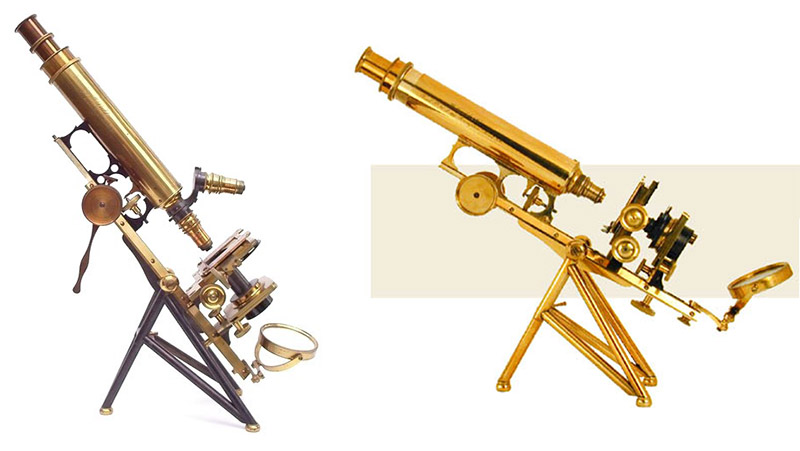
Figure 7.
Later versions of the “Jackson” pattern microscope. The instrument on the left is engraved “W. Ladd, Beak St. Regent St. W.”, dating it between 1860 and ca. 1871, while that on the left is engraved “W. Ladd & Co., Beak St. W and 199 Brompton Road, SW”, dating it to between ca. 1871 and 1882. A similar microscope, engraved “W. Ladd, 31 Chancery Lane, London”, and thus dating to between 1857 and 1860, may be seen at http://ar.utmb.edu/ar/Library/BlockerHistoryofMedicineCollection/BlockerHistoryofMedicineArtifacts/MicroscopeCollection/MicroscopesMakersandTheirInstruments/MicroscopeLadd/tabid/868/Default.aspx.
The images in this figure were adapted for nonprofit, educational purposes from http://www.antique-microscopes.com/photos/ladd.htm and
http://www.arsmachina.com/ladd1352.htm.
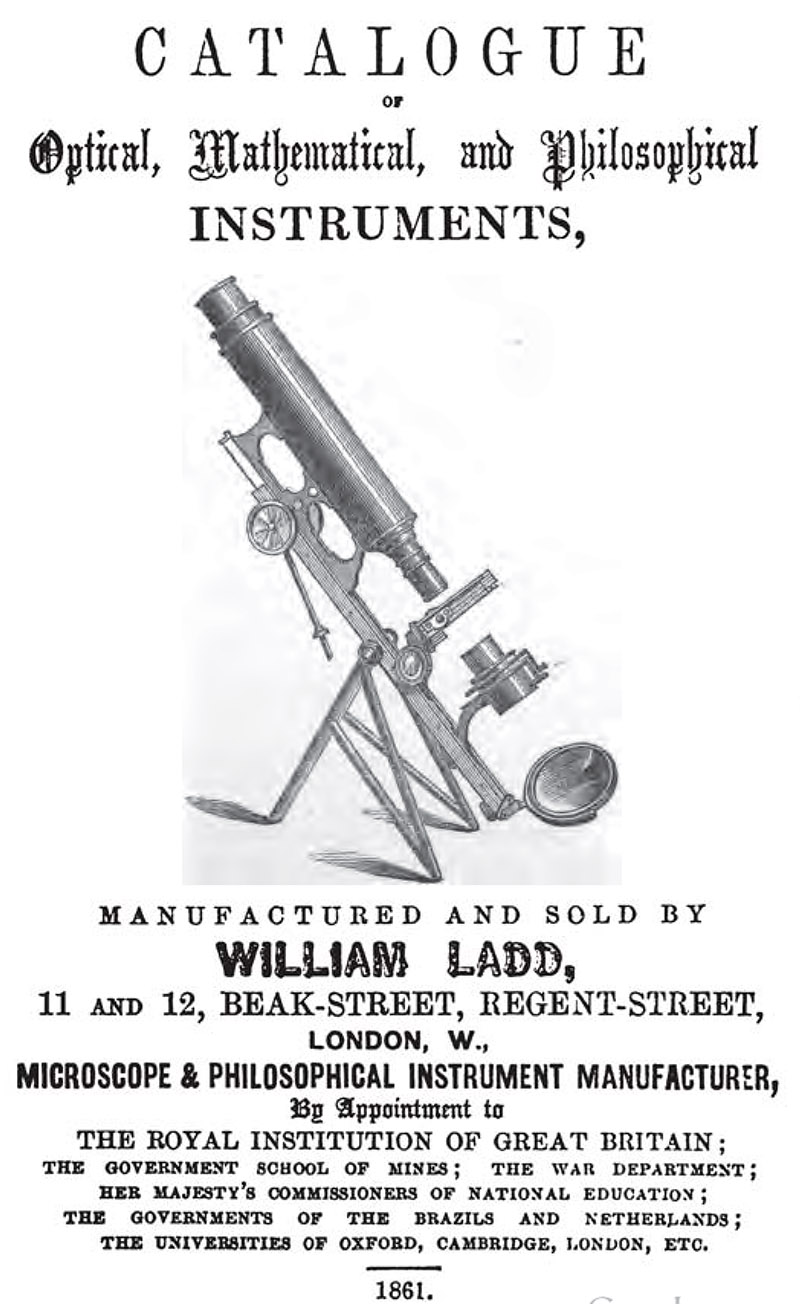
Figure 8.
Cover of William Ladd’s 1861 catalogue, featuring a picture of the microscope pattern shown in Figure 7. Ladd’s 1866 and 1868 catalogues also show this microscope. It is the only instrument pictured in any of those catalogues.
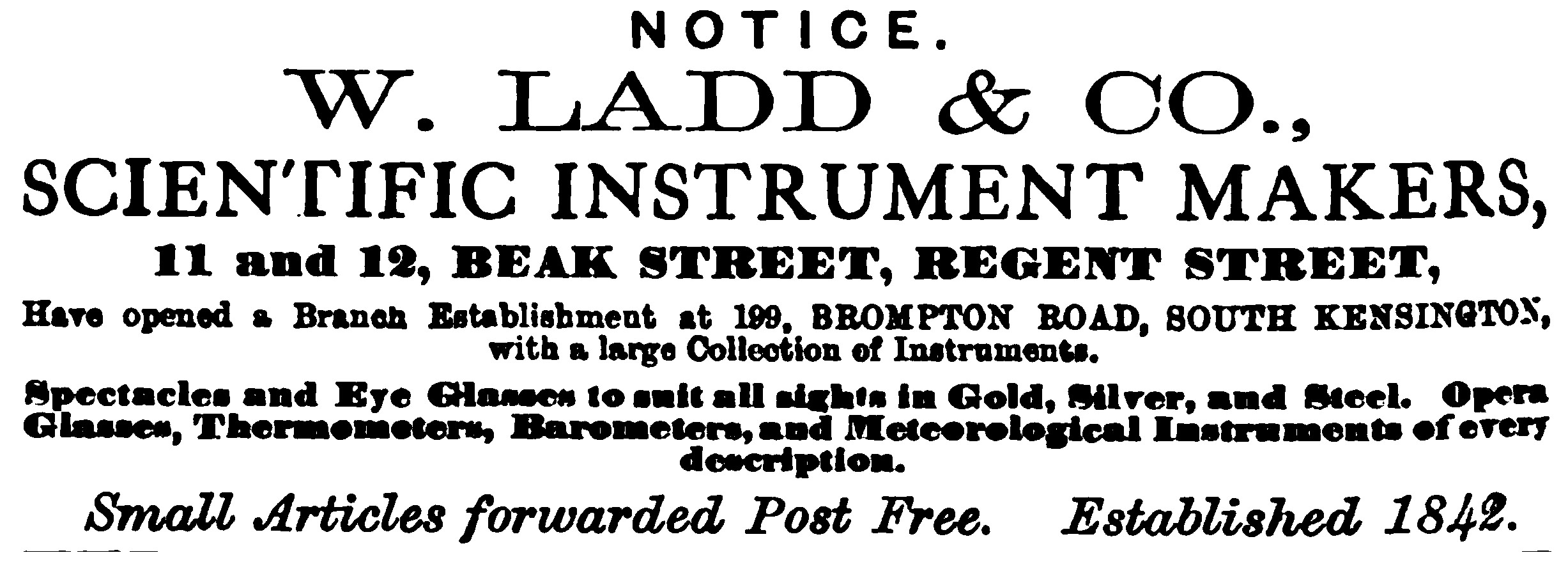
Figure 9.
An 1872 advertisement from “The Scholastic Register”, stating that William Ladd established his business in 1842. This ad also indicates that Ladd & Co. opened the branch shop at 199 Brompton Road, South Kensington, in 1872.
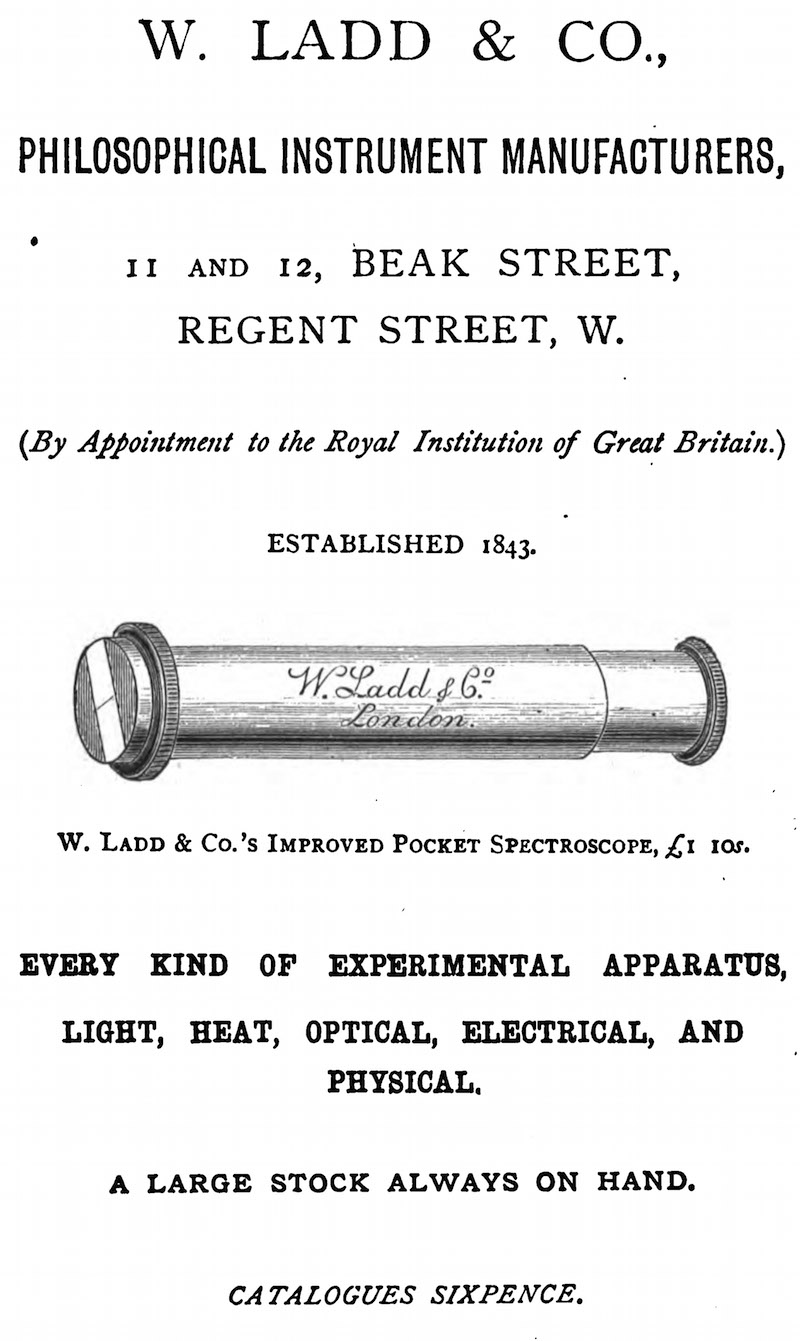
Figure 10.
An 1878 advertisement from “Light”, giving the different date of 1843 as the start of Ladd’s business.
William Ladd was born in Margate, Kent during early 1815, and christened on April 2 of that year. His parents were Edward Wilds Ladd, a baker, and Sarah Mummery Ladd. William’s elder brother, also named Edward Wilds Ladd (1800-1879), was likewise a scientific instrument maker. The brother apprenticed from 1816 to 1823 with William Harris, of High Holborn, London, and later, while in partnership with John Streatfield, took over the business of Robert Bate.
With whom William Ladd apprenticed is not currently known, but was presumably of a character comparable to Edward’s master. Noting that Ladd made adventitious use of the “fusee chain” as a focusing and stage-adjusting mechanism on his microscopes, that the fusee chain was an important aspect of clockwork mechanisms, and that William Harris was a member (and Master 1830-1832) of the Clockmaker’s Guild, there is a strong possibility that William Ladd was also apprenticed to Harris.
William married Ann Hickman on January 1, 1837, at St. Mark’s, Kennington. Apprentice contracts generally forbade marrying, so the 20-21 year-old William had likely completed his studies by that time. The parish records state that William was then an “optician”. The 1841 census records him as a “philosophical instrument maker”. Ladd later advertised that he began his business in 1842 or 1843 (Figures 9 and10). This implies that Ladd worked for an employer between ca. 1837 and ca. 1842.
A daughter, Phoebe Ann, was born in late 1837. She was William Ladd’s only child. Wife Ann died in 1844. William remarried within a few years, to a Caroline (maiden name unknown), who was 8 years older than him.
Ladd applied for patents in 1850 and 1851 for “adjustments for microscopes”. The 1850 patent, number 2809, is engraved on the instruments shown in figures 2 and 3, above. The nature of that patent is not obvious - the microscope in Figure 2 has rack-and-pinion focusing, so it did not regard chain-focusing.
At the 1851 London International Exhibition, Ladd showed, “Case of instruments for pneumatic experiments. Compound microscope, with chain and spindle in lieu of rack and pinion, now in use”. Ladd continued to use that mode of focusing throughout the rest of his career. He was awarded an Honourable Mention medal for his microscopes.
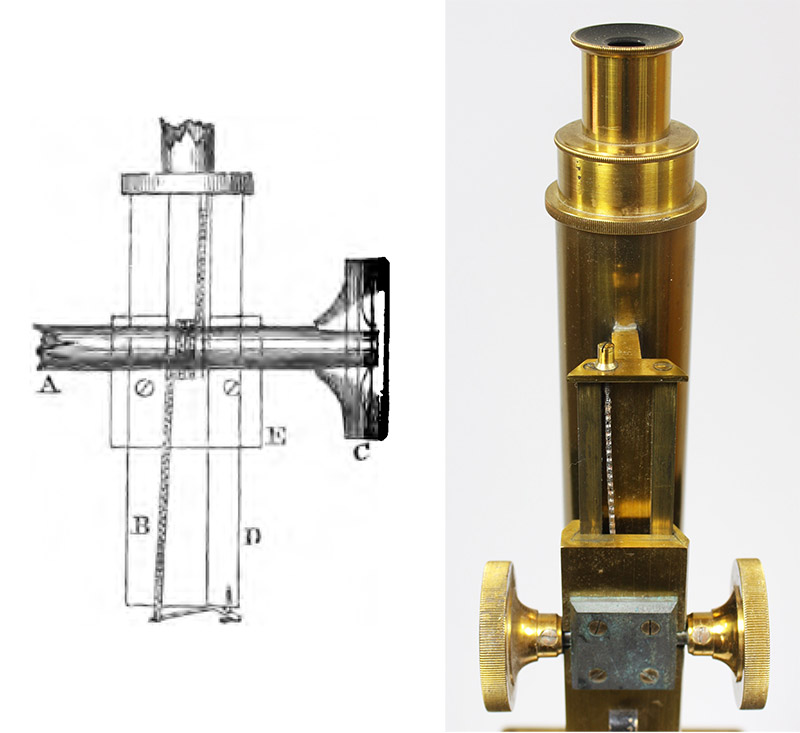
Figure 11.
Regarding Ladd’s “chain and spindle” focusing mechanism, Quekett wrote in 1855, “in (the left panel) is shown the mode in which the chain B is adapted to the triangular bar, D; C being the milled head for the coarse adjustment: the chain is one which is made for the fusee of timepieces, and it passes two or three times round the steel spindle, A, being kept strained either by a screw or spring… So true and smooth are these movements, that a fine adjustment for focussing is hardly required; and in none of the instruments examined by the author has he ever detected the least 'loss of time', even after a great deal of rough work”. An external view of a surviving chain-focusing mechanism is shown to the right.
Quekett also reported that Ladd produced his own lenses, indicating expertise in both glass and brass, “Mr. Ladd supplies, with his microscopes, object-glasses of his own construction; they vary in focal length from two iouse, New York, since July, 1878, anches to one quarter of an inch; the latter has an angle of aperture of 78°; the author has examined one of these, and can speak very highly of its performance. They are all distinct combinations except one, and this is the three fourths, which, by removing the cap containing the lower pair of lenses, becomes a one and a half inch. The half inch has an angular aperture of 57°, and the one inch of 23°. These object-glasses are less costly than those of the more celebrated opticians, although very superior to most continental ones”.
For the 1862 London Exposition, Ladd exhibited, “Focimeter for lighthouses; Induction Coils and apparatus; Microscope with magnetic stage; Air pump”. He earned a Medal “for his stands for microscopes, induction coils, &c.”. That prize featured prominently in later advertisements and catalogues, as did also his 1851 Honourable Mention and a Silver Medal at the 1867 Paris Exhibition (e.g. Figures 12 and 13).
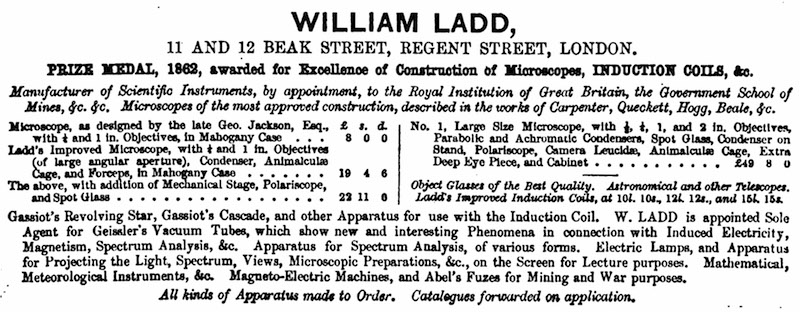
Figure 12.
Advertisement from the “International Exhibition, 1862, Reports by the Juries”.
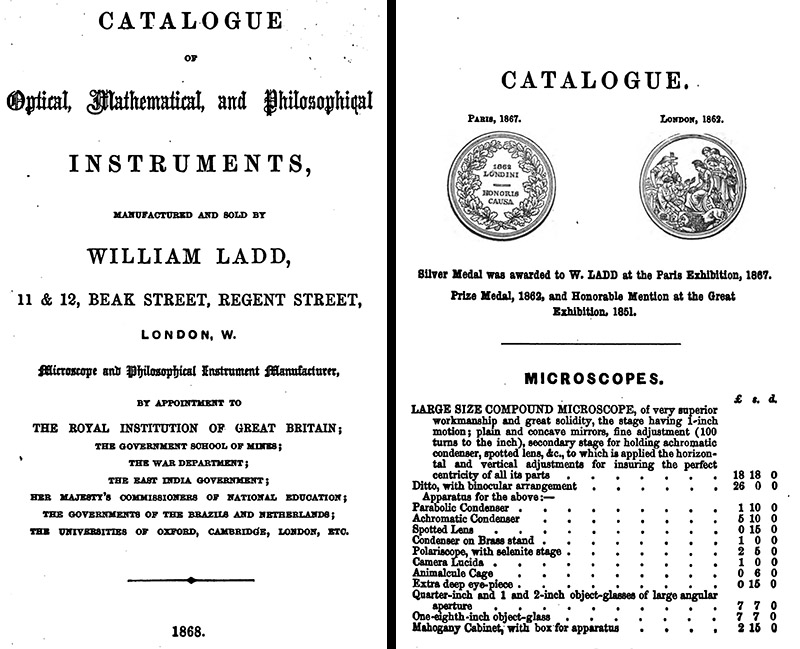
Figure 13.
Cover and first page of an 1868 Ladd catalogue, which was printed in the back of Henry Noad’s third edition of “The Inductorium”. The catalogue runs to 19 pages, of which only 3 pages are occupied by microscopes and related apparatus. Other major sections include telescopes, magic lanterns, polarized light devices, induction coils, frictional electricity apparatus, voltaic and magnetic apparatus, fuses, drawing instruments, meteorological instruments, pneumatic apparatus, instruments for studying acoustics and heat, photographic cameras, and “models of invention and all kinds of apparatus made to order”.
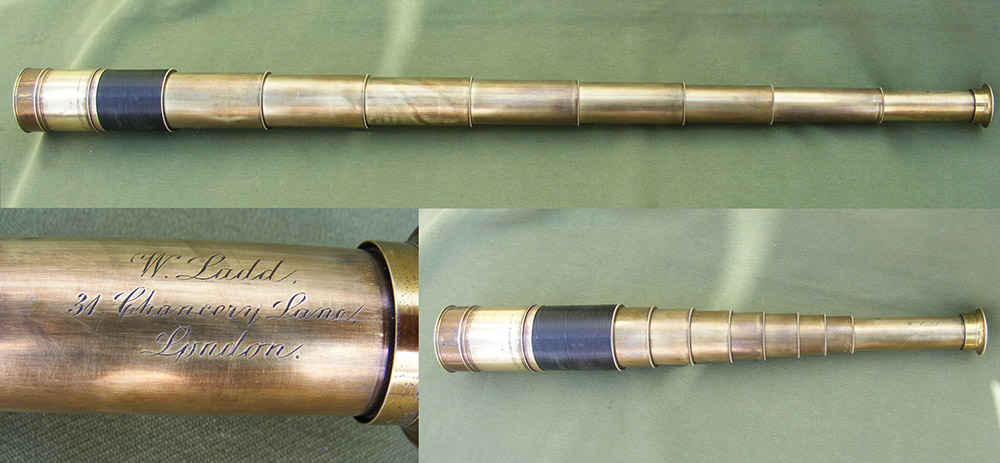
Figure 13B.
Eight-draw telescope from William Ladd. The address of 31 Chancery Lane dates it to 1857 - 1860. Adapted for nonprofit, educational purposes from an internet sale site.
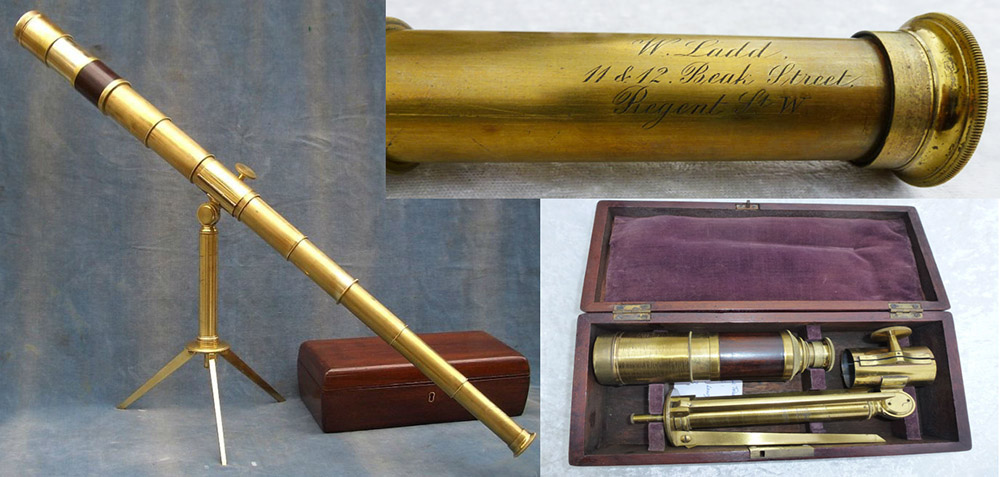
Figure 13C.
Ca. 1860-1871 library telescope from William Ladd, 11-12 Beak Street. Adapted for nonprofit, educational purposes from an internet sale site.
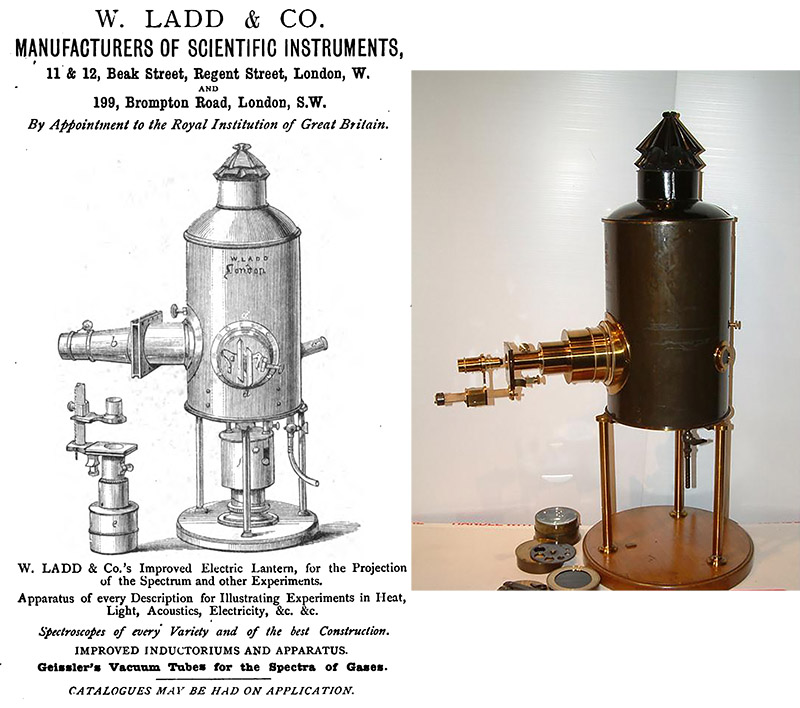
Figure 14.
Left, an 1873 Ladd advertisement, showing an electric projection lantern. Right, a surviving Ladd lantern, image adapted for nonprofit, educational purposes from http://collectionsonline.nmsi.ac.uk/detail.php?type=related&kv=3291&t=objects.
Ladd experimented with electricity, and developed new devices. From the early 1860s onward, electrical apparatus were a major focus of his retail business.
In March of 1863, Ladd was retained to produce and install electric lights for the Monument to the Great Fire of London, “Illumination Of The Monument By Electricity - We are informed that on the 10th inst. it is intended to place on the Monument five of the most powerful electric lights ever seen in London. The battery power will consist of no less than 420 Grove's cells. One light will be placed at each corner of the gallery, and one, placed on the top of the ball of fire, will be equal in power to the other four united, and will probably be seen at more than twenty-five miles' distance. The four corner lights will be thrown on the Monument, and will give it the appearance of being in a strong sunlight. The work will be intrusted to Mr. William Ladd, the philosophical instrument maker of Beak-street, Regent-street”.
“Ladd’s Dynamo-Magneto-Electric Machine” was first publicly exhibited at the Paris Exposition of 1867 (Figure 15). Obituaries of Ladd specifically mentioned this as an important invention.
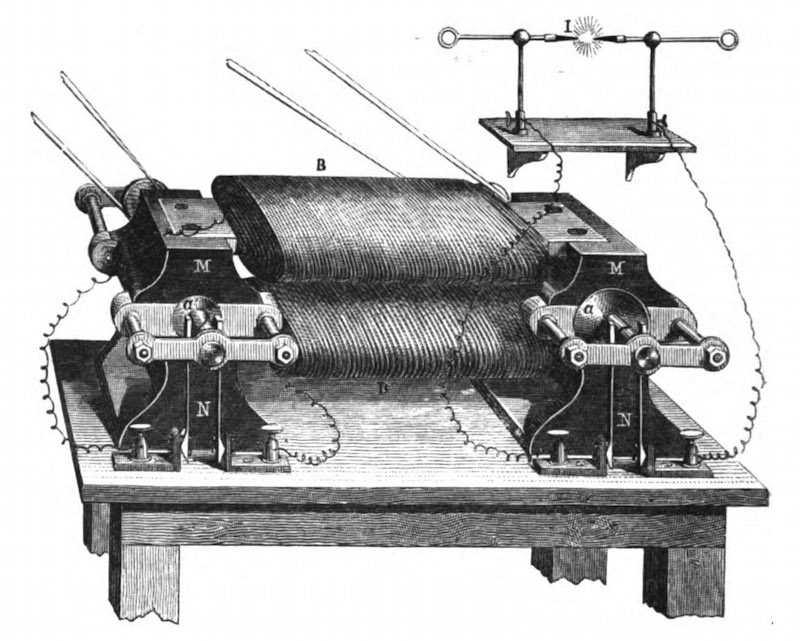
Figure 15.
A Ladd’s Dynamo, as illustrated and described in G.B. Prescott’s ‘Dynamo-electricity’, “ It employs, like the Wilde machine, two Siemens's armatures, but it differs from the latter principally in not having any permanent magnets whatever to charge the armature which supplies the horizontal field coils B B. Two long flat pieces of soft iron are placed within these coils and attached to the iron castings or pole pieces MM, NN, which are turned out just large enough for the armatures to fit inside of them and rotate without touching. Thick strips of brass or other non-magnetic metal are also placed between the upper and lower castings M and N, to keep them separate from each other, and thus subject the armatures between them to the full force of their inductive action. The connections of the coils are such as to produce opposite polarities in M and N; and the armature at the left of the machine supplies the field coils, while that at the right furnishes the current for the light”.
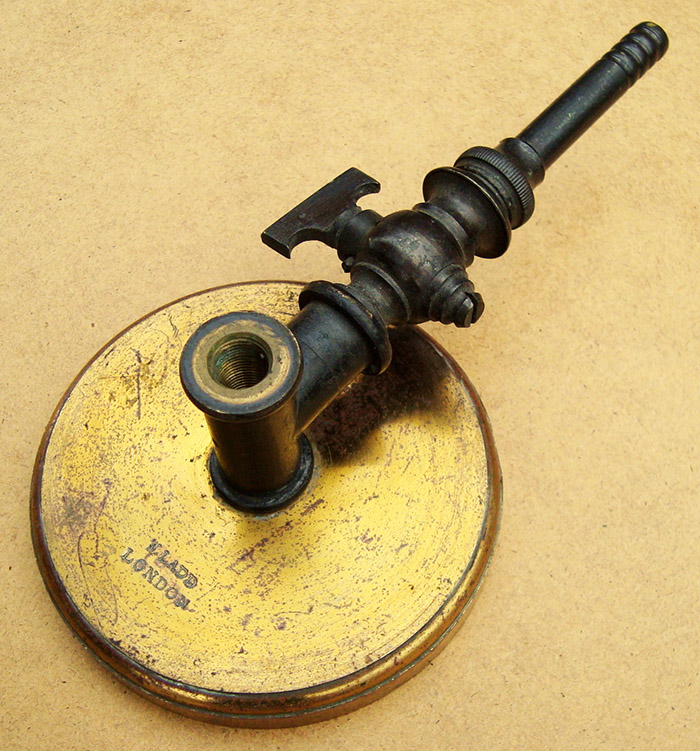
Figure 16.
A laboratory gas valve, for regulating a benchtop burner, signed "W Ladd London".
The Electrician (1885) reported that “In the year 1878, Mr. Ladd was instrumental in introducing into this country the Wallace-Farmer system of electric lighting from America, where it had met with considerable success. The dynamos and arc lamps employed on this system underwent considerable improvement at Mr. Ladd's hands; and one of the earliest installations of electric lighting afforded to the public was made under Mr. Ladd’s supervision on the above system at the Liverpool-street Terminus of the Great Eastern Railway. Mr. Ladd was from the time of its formation a director of the Anglo-American Brush Electric Light Corporation (Limited), and also of the Electrical Power Storage Company, and he took an active interest in the administration of these companies until almost the day of his death”.
Ladd joined the Society of Arts on March 4, 1857, and the Royal Astronomical Society on April 12, 1867. He was also one of the original members of the Physical Society of London, which formed in 1874.
William’s wife, Caroline, died during late 1874. He married a third time, on February 28, 1878, to Rosa Chevers, who was about 20 years younger than him.
Ladd retired and sold his business in 1882 (Figure 17). The business premises were taken over by W.G. Harvey and W.F. Peak (Figure 18).
William died on April 16, 1885. An obituary in the Proceedings of the Royal Astronomical Society noted that he had suffered from “a long and painful illness”. He left an estate of over £10000.
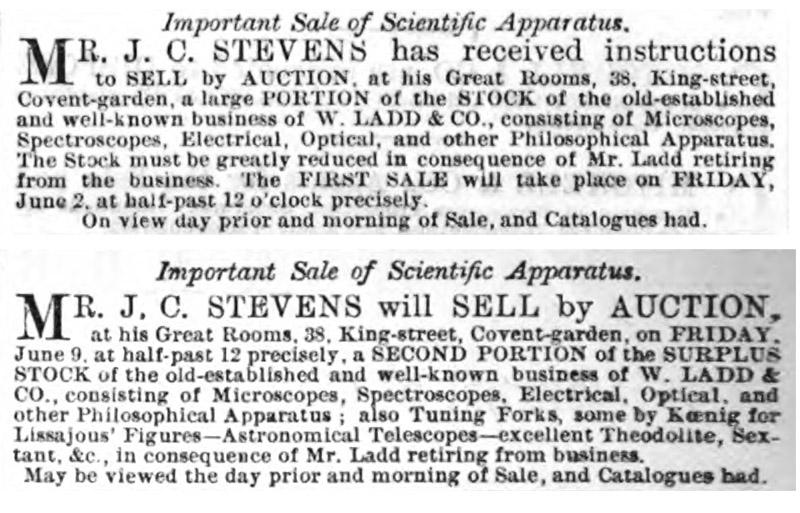
Figure 17.
Advertisements for the auction of “a large portion” of William Ladd’s stock, which took place on June 2 and June 9, 1882.

Figure 18.
A November 2, 1882, advertisement from Harvey and Peak, “Successors to W. Ladd & Co.”
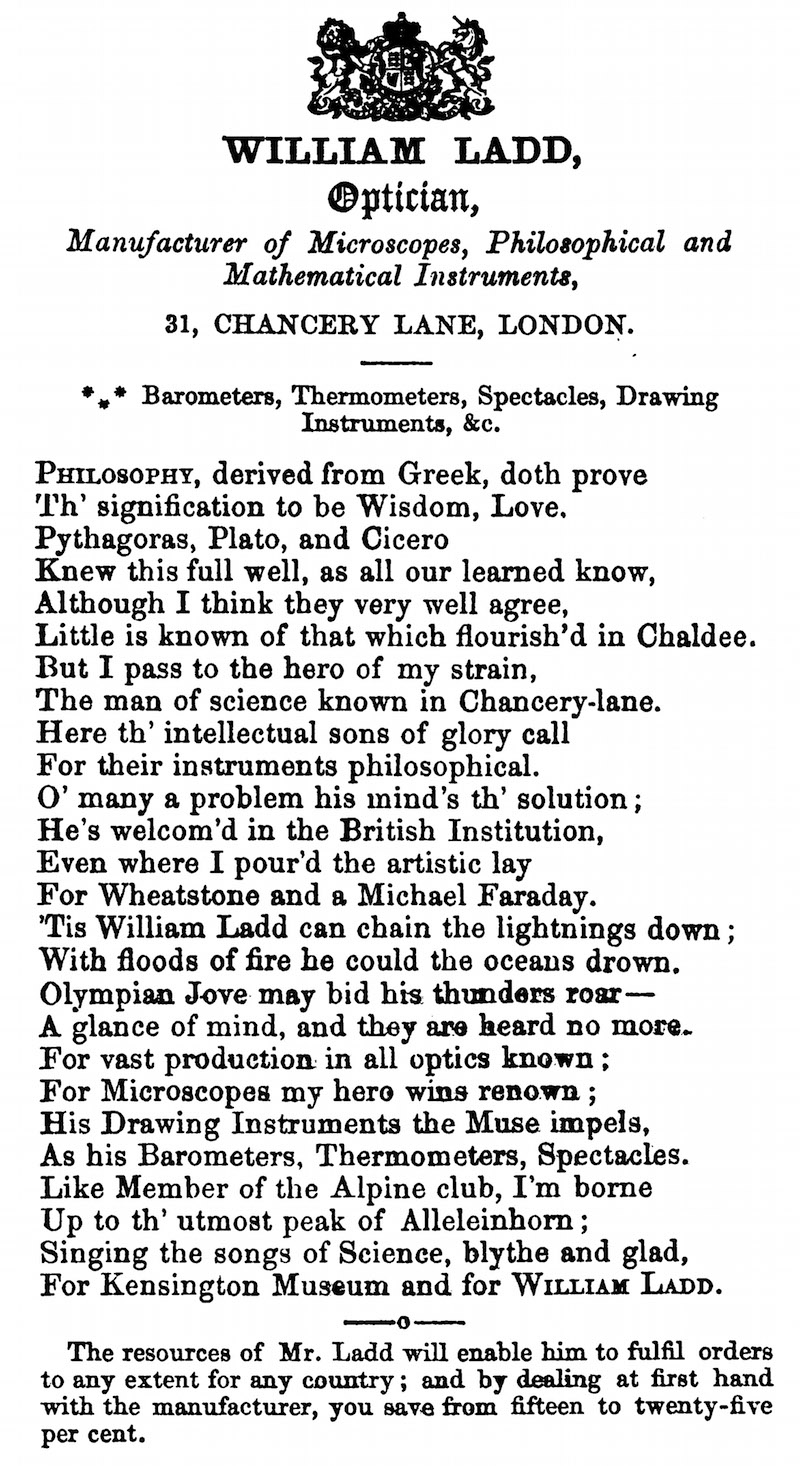
Figure 19.
Paean to William Ladd, by James Torrington Spencer Lidstone, from his 1860 “Seventh Londoniad (complete in itself), Giving a Full Description of the Principal Establishments, Together with the Most Honourable and Substantial Business Men, in the Capital of England, also Containing the Great Prize Poems on Prince Albert, and Leopold, King of the Belgians, and Pieces on Some of the Most Celebrated Personages in the Kingdom, and in the Provinces of British North American; Forming Altogether Episodes in a Grand National Poem of the Arts”.
Acknowledgements
Thanks to Allan Wissner and Yuval Goren for providing images and the Ladd microscope slide.
Resources
The Athenaeum (1882) Auction notices, April 29 (page 526) and June 3 (page 686)
Clifton, Gloria (1995) Directory of British Scientific Instrument Makers 1550-1851, Zwemmer, London, pages 125-126 and 161
The Electrician (1885) The late Mr. William Ladd, F.R.A.S., Vol. 14, page 495
The Engineer and Machinist (1850) “Designs for articles of utility…2809, W. Ladd, Walworth, adjustments for microscopes, May 13”, Vol. 1, page 128
England census, birth, marriage, death, and probate records, accessed through ancestry.co.uk and familysearch.org
Illustrated London News (1863) Illumination of The Monument by electricity, Vol. 42, page 259
International Exhibition, Reports by the Juries (1862)
Journal of the Society of Arts (1857) Vol. 5, page 243
Ladd, William (1861) Catalogue of Optical, Mathematical, and Philosophical Instruments
Ladd, William (1866) Catalogue of Optical, Mathematical, and Philosophical Instruments
Ladd, William (1868) Catalogue of Optical, Mathematical, and Philosophical Instruments
The Lancet (1856) Advertisement from William Ladd, Vol. 2, September 27 advertising section
The Lancet (1857) Advertisement from William Ladd of 31 Chancery Lane, Vol. 2, July 4 advertising section
The Lancet (1857) Advertisement from William Ladd, moving to 11-12 Beak Street, Vol. 2, September 22 advertising section
Lidstone, James T.S. (1860) The Seventh Londoniad, self-published, London, pages 33-34
Lockyer, J. Norman (1873) The Spectroscope and It’s Applications, advertisement from William Ladd
The London Gazette (1846) Announcements of the bankruptcy of Sarah Mummery Ladd, November 27 (page 5482) and December 25 (page 5992)
Mayer, Alfred M., and Charles Barnard (1878) Light, Macmillan & Co., London, advertisement from William Ladd at back of the book
Mechanics' Magazine and Journal of Science, Arts, and Manufactures (1851) “Weekly list of provisional registrations…Mar. 2, 116, W. Ladd Penton-place, Walworth Adjustments for microscopes, Volume 54
Monthly Notices of the Royal Astronomical Society (1885) William Ladd, Vol. 46, pages 191-192
Nature (1882) Advertisement from Harvey and Peak, November 2 advertising section
Noad, Henry M. (1866) The Inductorium, second edition, J. Churchill and Sons, London (Ladd catalogue included at the back of the book)
Noad, Henry M. (1868) The Inductorium, third edition, J. Churchill and Sons, London (Ladd catalogue included at the back of the book)
Official Catalogue of the Great Exhibition of the Works of Industry of All Nations (1851) page 63
Official Catalogue of the Industrial Department, International Exhibition (1862) page 47
Paris Universal Exhibition Catalogue (1855) page 23
Prescott, George B. (1884) Dynamo-electricity: Its Generation, Application, Transmission, Storage and Measurement, D. Appleton & Co., New York, pages 22-23
Proceedings of the Physical Society of London (1885) William Ladd, Vol. 8, pages 9-10
Quekett, John (1855) A Practical Treatise on the Use of the Microscope, Third Edition, H. Bailliere, London, pages 105-108
Remington, J.R. (1849) Suffering and triumph of an American, Western Literary Messenger, Vol. 11, pages 173-174
Schacht, Hermann (1855) The Microscope and It’s Application to Vegetable Anatomy and Physiology, Second Edition, S. Highley, London, pages 15-16
The Scholastic Register (1872) December 18, advertisement from William Ladd
Turner, Gerard L’E. (1981) Collecting Microscopes, Mayflower Books, New York, page 77
Turner, Gerard L’E. (1989) The Great Age of the Microscope, Adam Hilger, Bristol, pages 95-96 and 98-99
Tyler, Mr. (1849) Remington again, Scientific American, Vol. 4, page 163